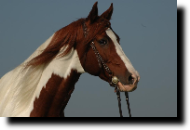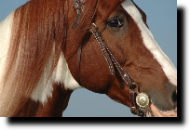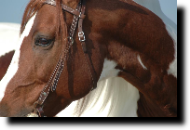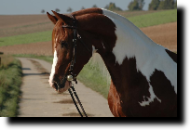Tishyno
Hauptmenü
R a s s e - breed
Organisationen:
Die Rasse der Quarabs existiert seit über 40 Jahren.
Sie wurden für die weitläufige Rancharbeit gezüchtet.
Es war nur eine Gebrauchszucht.
- 1984 wurde das United Quarab Registry von Tamara Grant in Ogden, Utah/USA gegründet..
- 1989 wurde der Index für gescheckte Quarabs hinzugefügt.
- 1999 eine neue Vereinigung die International Quarab Horse Association wurde von Lisa Striegle gegründet.
- 2002 MoRe Quarabs wurde in den Niederlanden gegründet.
- 2002 der Alaskan Quarab Horse Club entstand.
- 2004 wurde in Deutschland ein neuer Quarab Verein, die GQHA gegründet.
- 2006 wurde der European Quarab Breed Club (EQBC) gegründet.
- 2006 AICQA wurde in Italien gegründet.
Geschichte:
Indraff (Raffles x Indaia)
*09.05.1938
Aus dem Araber Hengst "Indraff" und der Quarter Stute "Cotton Girl" gehen 2 Halbaraber (Quarabs) hervor. "Indy Mac" und "Indy Sue". Beide wurden als Quarter Horses registriert."Indy Sue" wurde 1953 geboren und erwarb 44 AQHA Punkte in 6 unterschiedlichen Disziplinen (u.a Western Pleasure, Reining und Hunter under Saddle). 1960 bekam sie ihr ROM. Dieses Pferd war ebenfalls in der Cutting Horse Association erfolgreich. Als Zuchtstute hat sie 3 Quarter Horse Fohlen hervorgebracht.
"Indy Mac" war in Hunter Kreisen sehr erfolgreich.
Neben diesen Beiden gibt es Berichte über ein paar reinrassige Sabino Araber, die in der Paint Horse Association registriert waren, bevor das Zuchtbuch Anfang 1980 geschlossen wurde.
Rasse:
Der Quarab soll als Rasse die Eleganz des arabischen Pferdes mit der Charaktereigenschaften des Quarter oder Paint Horses vereinen. Der Quarab ist eine Kreuzung aus einem Araber und einem Quarter (AQHA) oder Paint Horse (APHA).
Kreuzungen mit einem Anteil von 12,5 bis 87,5 % zu Gunsten einer der beiden Rassen sind zulässig. Daneben dürfen keine weiteren Rassen eingekreut werden.
Rassestandard:
Quarabs haben generell eine Widerristhöhe von 142 bis 162 cm. Kleine Abweichungen sind möglich. Das Gewicht liegt bei 450 bis 600 kg.
Quarabs sollten eine gute Bemuskelung zeigen, aber dennoch weich und edel wirken. Der Körperbau ist kompakt, und von mittlerer Länge. Es gibt drei verschiedene Linien innerhalb der Quarabs: Straight, Stock und Pleasure Linie. Das generelle Erscheinungsbild eines Quarab sollte angenehm und niemals grobschlächtig sein. Der Körper sollte Stärke zeigen, und passendem Knochenbau und gut entwickelten Sehnen und Gelenken haben. Das Fell
sollte weich und fein sein. Der Kopf edel und einen wachen Ausdruck haben. Die Nüstern sollen groß sein und feinfühlig. Das Maul sollte klein sein mit einem starken Mund. Gut entwickelte Backenknochen zeigen Stärke. Quarabs können einen leichten Hechtkopf besitzen (Anzeichen ihrer arabischen Blutlinie). Diese Krümmung sollte jedoch nicht zu extrem ausgeprägt sein. Der Kopf sollte Qualität und Schönheit symbolisieren. Die Augen sind groß und ausdrucksstark. Als Augenfarbe kommt normalerweise dunkel vor. Es können jedoch auch blaue und hellbraune Augen vorkommen. Die Augen sollten einen klaren und glänzenden Ausdruck haben und gut auseinander liegen. Die Ohren sollten klein spitz und an den Spitzen gebogen sein. Beide Ohren sollten gut auseinander liegen und wachsam getragen werden.
Die Mähne und der Pony sollten füllig sein. Die Luftröhre sollte klar und gut ausgeprägt sein, jedoch nicht dick, so dass eine gute Atmung beim Arbeiten möglich ist.
Die Dicke des Halses hängt vom einzelnen Individuum ab. Der Hals sollte einen natürlichen Bogen haben. Stallions haben eine ausgeprägtere Krümmung wie Stuten oder Wallache. Der Hals sollte in einer weichen Linie mit der Schulter verbunden sein und am Übergang zwischen Hals und Schulter am tiefsten sein. Der Hals sollte lang und edel sein ohne schwach zu wirken. Die Dicke des Halses variiert etwas je nach Individuum.
Der Körperumfang sollte groß sein und genügend Platz für Lunge und Herz bieten. Der Rumpf sollte groß und rund jedoch schmal an den Flanken sein.
Der Widerrist sollte gut ausgeprägt sein, mittelhoch etwas höher als an den Hüften. Hierdurch entsteht eine gute Sattellage.
Die Schulter sollte gut gebogen sein mit guter Bemuskelung und guter Länge.
Der Rücken sollte kompakt, breit und tief sein über den Nieren sollte der Rücken voll und stark sein.
Die Beine sollten lang und gerade sein mit flachen Knochen und starken Gelenken. Der Unterarm sollte breit und gut bemuskelt sein. Das Sprungbein sollte kurz bis mittellang sein und nicht fleischig. Die Sehnen sollten weich über den Knochen liegen und stark und breit von der Seite aussehen. Von vorne betrachtet sollten sie gerade und dünn aussehen und genügend auseinander liegen. Die Hinterbeine sollten so stehen, dass der Quarab auf der Rückhand drehen kann und dabei die Beine unter seinem Körper hat. Die Fesseln sollten klar und stark sein, kurz bis mittellang und in ihrem Winkel zu den Schultern passen. Die Hüften sollten gut bemuskelt sein mit einem horizontal angebrachten Beckenknochen. Wenn der Quarab mit leicht ausgestellten Hinterbeinen steht (wie in der Halter Klasse) sollte die Kruppe beinahe waagrecht aussehen mit einer leichten Krümmung. Die Kruppe sollte jedoch nicht so extrem flach ein, wie beim Araber. Bei Bewegung sollte die Kuppe mehr gebogen sein, um einen guten Bewegungsablauf der Hinterbeine zu ermöglichen. Die Hinterbeine sollten innen und außen gut bemuskelt sein, um einen guten Antrieb zu ermöglichen.
Beim Betrachten von hinten sollten die Sprunggelenke nicht zu nahe beieinander stehen oder weiter auseinander als die Fesseln. Die Sprunggelenke sollten gerade, klarlinig und stark sein. Die Hufe sollten eine mittlere Größe besitzen, rund sein, mit einer Öffnung nach hinten. Sie sollten kompakt und dicht sein, nicht brüchig. Die Hufgröße sollte zur Größe und dem Gewicht des Pferdes passen. Der Schweif sollte ziemlich hoch getragen werden mit einem natürlichen Bogen und fröhlich getragen werden, speziell beim Trab. Die Bewegung hängt vom Individuum ab je nach Linie und Züchtung. Alle Quarabs sollten sich jedoch flüssig bewegen. Sie sollten gut von der Hinterhand her arbeiten, und eine versammelte Bewegung haben. Der Umfang an Bewegung hängt vom Züchtungstyp ab. Extrem träge Bewegungen sind jedoch unerwünscht.
Linien:
Es gibt unterschiedliche Typen oder Linien innerhalb der Quarabs:
Straight oder Foundation Type: Diese Linie sollte nicht extrem fein bzw. edel aussehen, jedoch einen starken Einfluss von beiden Blutlinien zeigen. Der durchschnittliche Quarab entspricht dem Straight Typ.
Stock Typ: Dieser Typ gleicht mehr dem Quarter/Paint Horse mit etwas Eleganz vom Araber.
Pleasure Typ: Dieser Typ gleicht mehr dem Araber. Er sieht vor allem am Kopf edler aus. Der Körper sollte jedoch den Einfluss des Quarter /Paints zeigen.




Organization:
" The breed has been around longer than its registry, started over 40 years.
" 1984, The United Quarab Registry was started by Tamara Grant of Ogden, Utah
" 1989, the Painted Quarab Index was added.
" 1999, a new association was formed, the International Quarab Horse Association, by Lisa Striegle
" 2002, MoRe Quarabs started in the Netherlands
" 2002, Alaskan Quarab Horse Club started
" 2004, a new association the German Quarab Horse Association, GQHA formed in Germany
" 2006, a new group was formed, the European Quarab Breed Club , EQBC
" 2006, AICQA is starting in Italy,
History:
"Indraff", a arabian-stallion sired two half-Arabians (Quarabs) who were registered as Quarter Horses (AQHA).
These are "Indy Mac" and "Indy Sue" both were out of the Quarter Horse mare "Cotton Girl".
Indy Sue was foaled in 1953 and earned 44 AQHA open performance points in six events, including Western Pleasure, Reining and Hunter Under Saddle. In 1960 she earned an open Performance Register of Merit. She had earnings with the National Cutting Horse Association as well. She was bred on to produce three registered Quarter Horse foals.
Indy Mac also was champion on the hunter circuit. There are also reports of a few purebred sabino Arabians that were inspected and registered in the American Paint Horse Association before their book was closed in the early 1980s.
breed:
The elegance of the Arabian horse and the character qualities of the Quarter Horse or Paint - that is the Quarab.
The Quarab is a horse that has solely Arabian and Quarter Horse (AQHA) or Paint Horse (APHA) blood. Crosses of 1/8 to 7/8 ( 12,5 - 87,5 %) percentages in favor of either breed type are allowed.
No other blood types are allowed.
breed standard:
Quarabs will generally range from 14.2 to 16 hands, although rare individuals may be slightly shorter or taller depending on the breeding. Weight is generally 900 to 1200 pounds.
Quarabs should appear well muscled, yet smooth and refined. They are compact and of medium length. Quarabs should exhibit a degree of refinement that will vary with their type - Straight, Stock or Pleasure. However refinement should always be present in the head and legs.
The overall appearance of the Quarab should be pleasing, never coarse, exhibiting good substance. The body should display good strength with sufficiently dense bone and well developed joints and tendons. The coat should be fine and smooth.
The head should be refined and reflect alert intelligence. Nostrils should be large and sensitive. The muzzle should be small with a firm mouth. Well developed jaws give the impression of strength. Quarabs may have a slightly concave, dished facial structure, hinting of the Arabian ancestry without being extreme; the amount of dish will vary with the type of individual. The head should demonstrate quality and beauty. Eyes should be large and expressive; they are generally dark but may be blue (double dilutes or pintos) or hazel (champagne colors). They should appear bright and clear and be set well apart on the head. Ears should be small, finely pointed and curving in at the tips. They should be set well apart and carried alertly.
Manes and forelocks should be full. The throatlatch should be clean and well defined, never thick, allowing for easy air flow when working. The neck should be smoothly joined to the shoulder and deepest at the point of attachment. The neck should be long and refined but not so fine as to appear weak.
Thickness of the neck will vary somewhat with the type of individual. The neck should display a natural arch. Stallions tend to have a more fully developed crest than either mares or geldings.
The chest should exhibit good depth and width. Ribs should be well sprung and close. Heart girth should be wide and solid to allow for ample lung and heart space. The barrel should be large and round, yet trim in the flank. The overall body should be deep and full in the mature Quarab.
Withers should be well defined and of medium height, slightly higher than the point of the hip, and should extend well back. This allows them to hold a saddle well. The shoulder should have a deep slope, be well muscled and of good length.
The back should be compact, broad and deep in the girth. It should be close coupled, full and strong across the kidney.
Legs should be long and sound, made up of flat bones and solid, large joints. The forearm should be broad and well muscled; it should taper to the knee. The Quarab should possess a short to medium length cannon bone that is free of meatiness. Tendons should lie smoothly over the bone, appearing wide and strong when viewed from the side. When viewed from the front, they should be straight, thin and set well apart. The hind legs should be placed so that the Quarab is able to turn on its hindquarters with the legs well under the body. Pasterns should be clean and strong, short to medium length and their angle should match that of the shoulder.
The hip should be quite muscled with a somewhat horizontally built pelvis. When standing with hind legs slightly apart (as in a halter class), the croup should appear nearly horizontal with little slope. However the croup should not be extremely flat as in many purebred Arabians. When moving or at work, the croup will appear more sloped allowing for good engagement of the hindquarters. Overall the hip and hindquarters should show great strength. The hind leg should be muscled inside and out to provide good driving power.
The hocks shall be neither close together nor wider apart than the fetlocks when viewed directly on from the rear. They should be clean, wide, strong and straight.
Hooves should be medium sized, nearly round and open at the heel. They should be smooth and dense, never brittle. Hoof size should be adequate for the size/weight of the individual.
The tail should be set fairly high, with a natural arch and carried gaily, especially at the trot.
Movement will vary with the individual, depending on its type and breeding. However all Quarabs should move freely. They should work well off their strong hindquarters and move in a collected manner.
While the amount of "action" will vary with breeding type, extreme "park" type action is to be avoided.
Quarabs may be virtually any color and may exhibit the white markings common to Arabians or Quarter Horses. Recognized colors include: chestnut, black, bay, palomino, buckskin, cremello, perlino, smoky creme (double creme dilution on a black base), red dun, dun, grullo, sorrel, brown, and champagne (of various shades). Roans and greys are designated with their base color: bay grey, black grey, sorrel grey, etc.
Recognized patterns include roan, gray, tobiano, overo, and tovero. Roan and grey are uniquely listed as patterns
types:
Body types may be customized, as there are definite preferences among breeders for the different types.
Straight or Foundation Type animals should be a good blend of the traits of both the Arabian and the Quarter Horse/Paint. They should not be overly refined but should exhibit strong influence from both bloodlines. The Quarab Standard is that of the Straight Type Quarab.
Stock Type animals will demonstrate more of those traits commonly associated with the Quarter/Paint but should retain an elegance and typiness from the Arabian.
Pleasure Type animals will more closely resemble their Arabian ancestry with more refinement, especially in the head. However, the body should still show a strong influence from the Quarter/Paint blood.